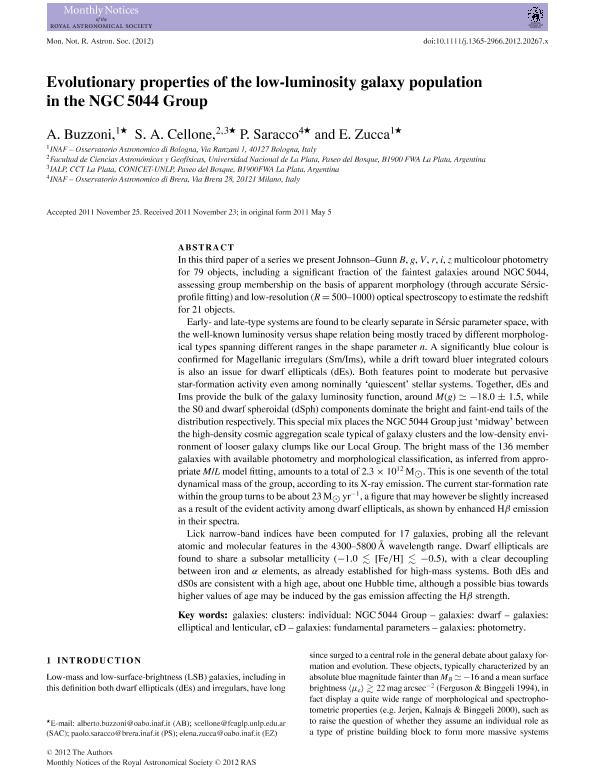Artículo
Evolutionary properties of the low-luminosity galaxy population in the NGC5044 Group
Fecha de publicación:
03/2012
Editorial:
Wiley Blackwell Publishing, Inc
Revista:
Monthly Notices of the Royal Astronomical Society
ISSN:
0035-8711
Idioma:
Inglés
Tipo de recurso:
Artículo publicado
Clasificación temática:
Resumen
In this third paper of a series we present Johnson-Gunn B, g, V, r, i, z multicolour photometry for 79 objects, including a significant fraction of the faintest galaxies around NGC5044, assessing group membership on the basis of apparent morphology (through accurate Sérsic-profile fitting) and low-resolution (R= 500-1000) optical spectroscopy to estimate the redshift for 21 objects. Early- and late-type systems are found to be clearly separate in Sérsic parameter space, with the well-known luminosity versus shape relation being mostly traced by different morphological types spanning different ranges in the shape parameter n. A significantly blue colour is confirmed for Magellanic irregulars (Sm/Ims), while a drift toward bluer integrated colours is also an issue for dwarf ellipticals (dEs). Both features point to moderate but pervasive star-formation activity even among nominally 'quiescent' stellar systems. Together, dEs and Ims provide the bulk of the galaxy luminosity function, around M(g) ≃-18.0 ± 1.5, while the S0 and dwarf spheroidal (dSph) components dominate the bright and faint-end tails of the distribution respectively. This special mix places the NGC5044 Group just 'midway' between the high-density cosmic aggregation scale typical of galaxy clusters and the low-density environment of looser galaxy clumps like our Local Group. The bright mass of the 136 member galaxies with available photometry and morphological classification, as inferred from appropriate M/L model fitting, amounts to a total of 2.3 × 10 12M ⊙. This is one seventh of the total dynamical mass of the group, according to its X-ray emission. The current star-formation rate within the group turns to be about 23M ⊙yr -1, a figure that may however be slightly increased as a result of the evident activity among dwarf ellipticals, as shown by enhanced Hβ emission in their spectra. Lick narrow-band indices have been computed for 17 galaxies, probing all the relevant atomic and molecular features in the 4300-5800Å wavelength range. Dwarf ellipticals are found to share a subsolar metallicity (-1.0 ≲ [Fe/H] ≲- 0.5), with a clear decoupling between iron and α elements, as already established for high-mass systems. Both dEs and dS0s are consistent with a high age, about one Hubble time, although a possible bias towards higher values of age may be induced by the gas emission affecting the Hβ strength.
Archivos asociados
Licencia
Identificadores
Colecciones
Articulos(IALP)
Articulos de INST.DE ASTROFISICA LA PLATA
Articulos de INST.DE ASTROFISICA LA PLATA
Citación
Buzzoni, A.; Cellone, Sergio Aldo; Saracco, P.; Zucca, E.; Evolutionary properties of the low-luminosity galaxy population in the NGC5044 Group; Wiley Blackwell Publishing, Inc; Monthly Notices of the Royal Astronomical Society; 420; 4; 3-2012; 3427-3450
Compartir
Altmétricas
Items relacionados
Mostrando titulos relacionados por título, autor y tema.
-
Artículo New quantitative nitrogen abundance estimations in a sample of Seyfert 2 active galactic nucleiDors Jr., O. L.; Arellano Córdova, K. Z.; Cardaci, Monica Viviana ; Hägele, Guillermo Federico (Wiley Blackwell Publishing, Inc, 2017-06)
-
Dors, Oli L.; Agarwal, B.; Hägele, Guillermo Federico ; Cardaci, Monica Viviana ; Rydberg, Claes Erik; Riffel, R. A.; Oliveira, A. S.; Krabbe, A. C. (Wiley Blackwell Publishing, Inc, 2018-09)
-
Carvalho, S.P.; Dors, O. L.; Cardaci, Monica Viviana ; Hägele, Guillermo Federico ; Krabbe, Nora Cristina; Pérez Montero, E.; Monteiro, A.F.; Armah, M.; Freitas Lemes, P. (Wiley Blackwell Publishing, Inc, 2020-06)




